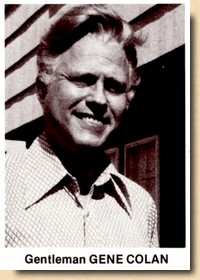 |
|
Eugene
"Gene" Colan (nicknamed both "Gentleman"
and "the Dean" at
Marvel by Stan Lee) was born on 1
September 1926 in the Bronx, New York
City, and passed away on 23 June 2011 in
New York City. He
had grown up and received his education
in the Big Apple and graduated from
George Washington High School in
Washington Heights (Manhattan) before
going on to study at the Art Students
League of New York under renowned
illustrator Frank Riley and the famous
surrealistic, modern Japanese painter
Kuniashi (genecolan.com).
"My
mother owned an antique business.
(...) My father was in the insurance
business. I was into art, very early
on. I started at about three, and I
drew everything in sight (...) That
was my passion, and I didn't care
about anything else, not really (...)
I had my pencil and pad, and I was
set." (Irving, 2010)
|
|
|
| |
During World War II, a two
year ticket with Special Services in the Army Air
Corps found Corporal Colan in the Philippines
where his artwork brightened the pages of the Manila
Times and won him numerous awards.
"I
wanted to have something to do with film
making when I was very young, but I didn't
think I'd really make it in that. (...) Being
a very sensitive person, I wouldn't be able
to handle what Hollywood dishes out. (...) I
chose going into comic books because it's
storytelling, and not just drawing, but
telling good stories. (...) Milton Caniff was
my biggest influence, and the artist who
inspired me the most. There may have been
better artists than he, but he had a way with
shadows and blacks when he did "Terry
and the Pirates" that I loved so
much." (Irving,
2010)
Back
in the US, Gene Colan's official career in comics
began in 1944 at Fiction House, where he saw his
first work - a one-page filler illustration of a
P-51B Mustang - published in Wings Comics
#52 (December 1944), whilst his first work on an
actual comics story - a seven-page "Clipper
Kirk" feature - was published in the
following month's issue (genecolan.com / Best,
2003).
|
|
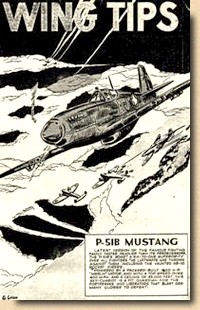 |
|
| |
In 1946,
Gene decided to go for a permanent job in the comic
industry and submitted his work to both National (DC) and
Timely (Marvel) Comics.
"I
was living with my parents. I worked very hard on a
war story, about seven or eight pages long, and I did
all the lettering myself, I inked it myself, I even
had a wash effect over it. I did everything I could
do, and I brought it over to Timely (...) and [Al
Sulman] came out and met me in the waiting room,
looked at my work, and said 'Sit here for a minute'.
And he brought the work in, and disappeared for about
10 minutes or so... then came back out and said 'Come
with me'. That's how I met Stan [Lee]. Just like
that, and I had a job." (Thomas, 2000)
In the end,
Stan Lee was impressed enough to hire Gene for around
sixty odd dollars a week (genecolan.com).
"When
I first started with Timely (...) we were working in
the Empire State Building and that’s where I
really got the experience that I needed. I was
hired to do the work and I was paid for it and I
didn’t know a heck of a lot about anything and
of course there was an art director there, his name
was Syd Shores and he showed me everything.(...) he
was just great. Captain America, Two Gun Kid,
Kid Colt, westerns, and horses - he could do
anything, and he helped me a lot. He brushed up
all the bad stuff that I was doing." (Best,
2003)
But only two
years later, Timely decided to use up a large inventory
of accumulated unpublished artwork - with both obvious
and tough results for the artists.
|
| |
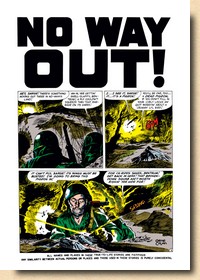
Battlefield
#5
(November 1952)
|
|
"The
bottom dropped out and we had to take
what we could get. (...) It happened
at a time [in 1948] when everybody in
the art department was let go. (...)
People would have to fend for
themselves, getting freelance or
whatever. (...) I decided to take the
day off and decided to see what I
could get. I came back with some good
accounts: Quality Comics was one, and
I worked for Ziff-Davis, and maybe
one or two others." (Irving,
2010)
Also in 1948 Colan
became a freelance artist for National
(DC). Always striving for complete
accuracy, Gene Colan meticulously
researched his countless war stories for
DC such as All-American Men at War
and Our Army at War, as well as
Atlas Comics' Battle, Battlefront,
G.I. Tales, Marines in Battle
and Navy Tales (to name only a
few). His earliest confirmed credit
during this time is pencilling and inking
the six-page crime fiction story
"Dream Of Doom" in Lawbreakers
Always Lose #6 (Atlas, February
1949).
Following the Wertham
scare of 1954 and the downturn the
industry faced Gene Colan left comic
books for good for a number of years
before returning to the medium in 1962.
Initally working for DC and Dell, he also
began to do some occasional work for
Marvel as of 1963 with mystery backups on
Journey into Mystery and Western
stories.
|
|
|
| |
| In 1965 Colan did his first
superhero work on Sub-Mariner and Iron Man under
the pseudonym of Alan Austin (as he was still
primarily working for DC), a modus operandi
which was quickly dropped as his style was so
unique that the authorship of the artwork was too
evident to be hidden behind an alter ego. And again,
Gene Colan was looking to provide his artwork
with authenticity and accuracy.
"Authenticity,
for me, was important, because it made the
reader feel 'This is real This is not just a
comic book' (...) It gave the reader the
sense that he belonged in the story and
wasn't just reading something. I romanced it
in my head: I was into it and wanted the
reader to be into it." (Irving,
2010)
"I
would take stuff out of magazines,
newspapers, anything that I thought would be
useful. (...) Through the years
I’ve compiled such a collection of
pictures dealing with every conceivable
subject that I very seldom ever have to go
anywhere to get outside information because
being in the business fifty some odd years
you get quite a collection." (Best,
2003)
By
1966 Gene Colan was firmly established as the
artist of several ongoing Marvel series and
characters, and took on Daredevil which
would become his signatory title for many.
Other
Marvel titles which Gene Colan had lengthy runs
on and was applauded for included Iron Man,
Captain America and Doctor Strange
before he took on all 70 issues of Tomb of
Dracula as of 1972 - the series is
one of the seminal monuments to his artistic
expertise and craftmanship. He also made waves
with his pencils on Marvel's satirical Howard
the Duck, which kicked off in 1976.
Gene
Colan won the Shazam Award for Best Penciller
(Dramatic Division) in 1974, received the 1977
and 1979 Eagle Award, and was nominated for five
Eagle Awards in 1978.
However,
when Jim Shooter became editor-in-chief in 1978,
the fun times at Marvel were coming to an end for
Gene Colan.
"I
knew the trouble was heading my way with
Shooter. He overcorrected every single line I
drew on every single panel (...) he was about
tyranny just for the sake of it." (Irving,
2010)
Shooter's
own take on that period in time makes it quite
clear that even though they were working in the
same business the two men had completely opposite
views and understandings of their trade:
"I
said "You've gotta do better stuff. I'm
gonna make you redraw when you don't."
(...) That's when Wolfman had gone over to
DC, thinking fondly of the Dracula days, got
him to come over [to DC]. And that was better
for everybody I think." (M.
Thomas, 2000)
|
|
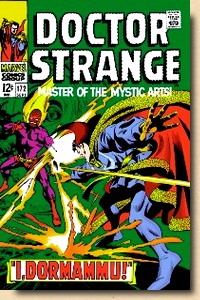
Doctor Strange #172
(September 1968)
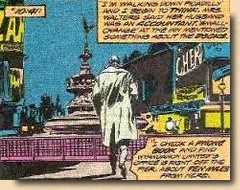
Gene Colan's Picadilly Circus
sets the scene in Tomb of Dracula #25
(October 1974)
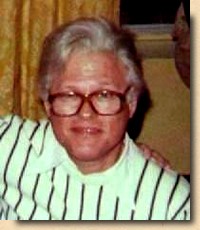
Gene Colan in 1977
|
|
| |
| After
splitting from Marvel for both creative and professional
reasons, Gene Colan thus found himself back once again at
DC Comics in 1982, where he reunited with Marv Wolfman
whom he had worked with so long and so successfully at
Marvel. |
| |
| DC was eager to promote this
dream team which now was part of their own ranks,
but their reunion project Night Force
(featuring a team of individuals fighting
supernatural threats) which billed Wolfman and
Colan as the "Masters of the
Macabre" only lasted for 14 issues
before cancellation. 
This
was in spite of obvious attempts by the creative
team to somehow continue the legacy of Tomb
of Dracula - one of the main characters was
Vanessa van Helsing, granddaughter of Abraham van
Helsing, which would thus make her a sister of
Rachel van Helsing from Tomb of Dracula.
Gene
Colan was far more successful in bringing his
shadowy and moody visuals to Batman, one of whose
primary artists he became from 1982 to 1986 in
both Detective Comics and Batman,
even though his overall pencilling did become
somewhat lighter due to DC's very strict art
policy.
"Dick
Giordano gave [Batman] to me. I enjoyed
drawing Batman, but my experience working for
the company and the editor on the book left
something to be desired." (Klaehn,
2010)
"DC
was a tough outfit. They wanted an in-house
look for all of the artwork, and they wanted
the artists to draw somewhat the same." (Irving,
2010)
"DC
was way too controlling, and no artistic
freedom (...) Marvel was like working for
family, DC like working for the
principal." (Klaehn,
2010)
Nonetheless,
Gene Colan's visions of Batman matched up well
with the character's eesentials as shaped by
Denny O'Neil and Neal Adams:
"[Batman
is] a very mysterious figure of the night
(...) [a classic Batman story is] something
mystifying and unearthly, left to the reader
to figure out." (Klaehn,
2010)
When
Conway and Colan delved into a multi-issue story
arc in mid-1982 which had Batman fighting
vampires, it could have been perceived as a
typecast gridlock for Gentleman Gene. However,
the resulting epic story spread out across Batman
#349, Batman
#350, Detective
Comics #517, Batman
#351 and Detective
Comics #518 became an instant classic
which had readers in rapture.
At
DC Gene Colan also pencilled Wonder Woman
from 1982 to 1983, worked with Greg Potter on Jemm,
Son of Saturn (1984-85), with Cary Bates on Silverblade
(1987-88), and he pencilled the first six issues
of Doug Moench's 1987 revival of The Spectre.
Between
1981 and 1986 Colan also managed to break free
from the established comic book industry
production chain of penciller and inker by
creating finished drawings in graphite and
watercolor on projects such as the feature
"Ragamuffins" in Eclipse as well
as in the DC Comics noir miniseries Nathaniel
Dusk (1984) and Nathaniel Dusk II
(1985–86), all of which were written by Don
McGregor.
|
|
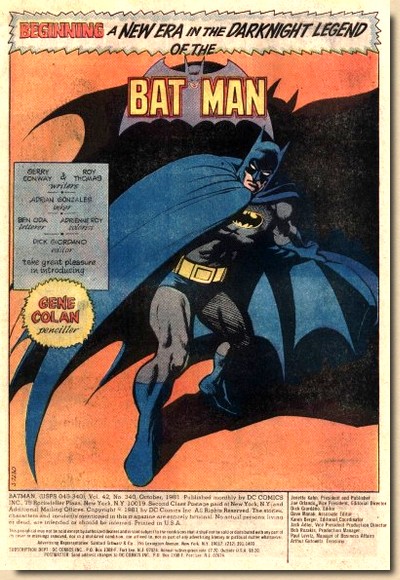
Gene Colan is formally
introduced to the readership on the splashpage of
Batman #340 (October 1981)
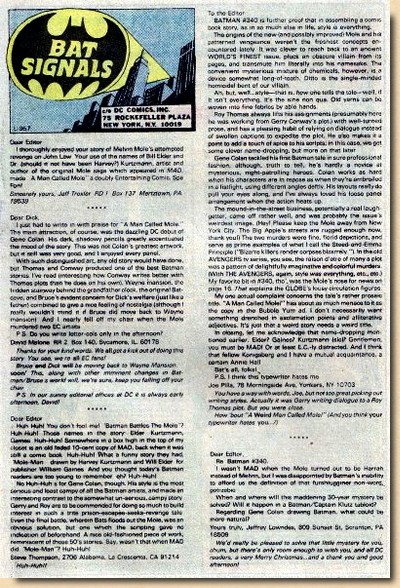
First and enthusiastic
readers' reactions to Gene Colan's appointment to
the Batman Universe on the letters page of Batman
#345 (March 1982)
|
|
| |
Gene Colan
also did a fair amount of work for independent
comic book publishers before returning to Marvel
in 1990 where he once again collaborated with
Marv Wolfman on a new The Tomb of Dracula
series and returned to Daredevil in
1997, the title for which he had produced some of
his most classic and best loved superhero artwork
for Marvel in the late Silver and early Bronze
Age.
In 2005, Gene Colan was
inducted into the comics industry's Will Eisner
Comic Book Hall of Fame. In 2007, he pencilled the
final pages of Blade (vol. 3) #12
depicting a flashback in which Blade dresses in
his original outfit from the original 1970s
series, and that same year, he also drew 3 pages
(18-20) for the anniversary 100th issue of volume
two of Daredevil.
He continued to draw
occasional comics and covers throughout his
retirement, his last work being for Captain
America #601 (September 2009) for which he
won yet another Eisner Award, this time for Best
Single Issue (together with writer Ed Brubaker).
"I didn't have a
deadline. (...) It took me close to two
years." (Irving, 2010)
This award - together with
the Comic Art Professional Society's Sergio Award
which he recived in October 2009 - no doubt
marked a fitting end for a unique career of an
artist whose professionalism and dedication made
him a legend of the comic book industry and 20th century
popular culture in his own lifetime.
"You
know you can draw a fine picture, but unless
somebody sees it and appreciates it, it means
nothing. You’ve got to get somebody to
say to you “Gee that was a good picture
you drew” or that was a good story you
did, and you don’t get that very much in
this business, you don’t get those kind
of compliments all that much." (Best,
2003)
"Most
of the inspiration came from films and to me
the movie screen was just one gigantic comic
book panel." (Best,
2003)
"You
know comic book artists never sit down at a
convention table to discuss how they're gonna
do this and how they're gonna do that - it
was always over the phone, very quickly, or
in passing each other you'd spend a few
minutes talking about it, maybe fifteen or
so, and that would be it. It's all that was
required." (Siuntres,
2005)
"It’s
very hard to get a good inker to go
over. If you were a penciler and you
did fabulous pencil work, or what you thought
was pretty darn good and then you give it to
an inker, well then you’ve got your
style to begin with and then you’ve got
the inkers style on top of your style.
And you’ve got two styles representing
one piece of art. And I’ve always
had a problem getting a good inker." (Best,
2003)
When
Gene Colan passed away on 23 June 2011, the
American comic book industry lost a true giant of
a legend - one of the best and most prolific
artist and entertainer the medium ever had..
|
|
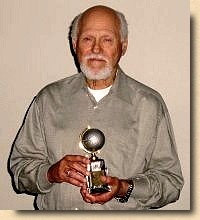
Gene Colan receiving his
Eisner Award in 2005
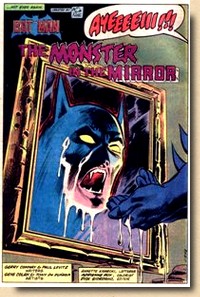
Detective
Comics #517
(August 1982)
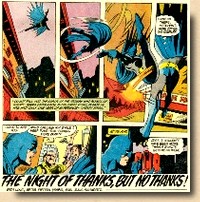
Detective Comics #567
(October 1986)
|
|
| |
Stan
Lee: "Trying to describe Gene
Colan's incredible artwork is like trying to describe
a rainbow. The best way to appreciate it is to look
at it. (...) He could do romance, horror,
superheroes, whatever it was he could do it and he
did it with great style." (Comic Book
Profiles No. 6, Spring 1999)
Marv
Wolfman: "His graphic was
perfect, Gene is a brilliant artist." (Siuntres,
2006)
Jim
Lee: "His ability
to create dramatic, multi-valued tonal illustrations
using straight India ink and board was
unparalleled." (Boyle, 2011)
Kelly
Jones: "There's no comics
artist I can think of offhand who draws human facial
expressions as well as Gene and very few who are as
good as Gene at setting a mood." (Comic
Book Profiles No. 6, Spring 1999)
Steve
Gerber: "If I
was to say one thing about Gene Colan's work, it's
atmosphere and rhythm, because the lines are so
musical. They flow into one another, and you can hear
the snap of Dracula's cape. You can hear Daredevil
whizzing by you - it's terrific. Not too many artists
are capable of that." (Comic
Book Profiles No. 6, Spring 1999)
Tom
Spurgeon: "He was his own chapter
in the history of comics." (Moore &
Ilnytzky, 2011)
Gerry
Conway: "I had three favorite
artists that I worked with in my career and they
would be Ross Andru (...) Jose Garcia-Lopez (...) and
Gene Colan. Because we had two really good runs
together on Daredevil in the early 70's and on Batman
in the early 80's. Those are sort of the three
artists who I feel happiest in terms of long
relationships with (...) those were the guys I think
I did some of my best work with." (Daudt, n.a.)
|
| |
| But Gene
Colan was not only a master of his trade, he was also a
witty and sharp observer and analyst of 20th century
American comic book culture and its industry, of which he
had a lengthy and
seasoned first hand working knowledge. He made himself
available for many interviews, and thanks to Gene Colan's
willingness to put forward his thoughts - "I
always have something to say about the industry"
- many an information and insight on production methods
and publishing politics which otherwise would have been
lost in time is now on record for all who are interested
in comic books and their history. |
| |
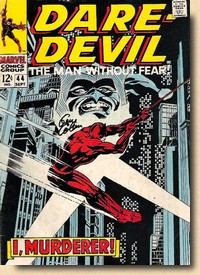
Daredevil
#44
(September 1968)
cover signed by Gene Colan
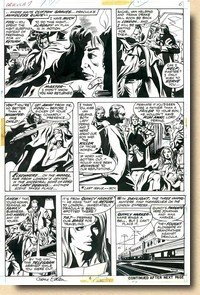
Tomb of Dracula
#7, pg 6
(March 1973)
original artwork by Gene Colan, expertly
inked by Tom Palmer
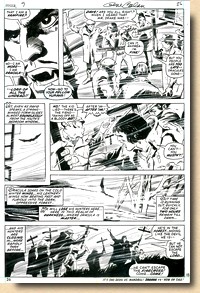
Tomb of Dracula
#9, pg 26
(June 1973)
original artwork by Gene Colan, inked by
Vince Colletta, notorious for his
tendency to "simplify"
pencilwork and leave out a lot of detail
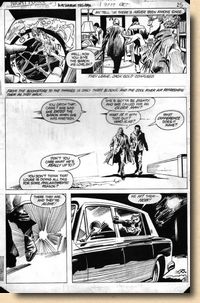
Night Force #3,
pg 20
(October 1982)
original artwork by Gene Colan, inked by
Bob Smith
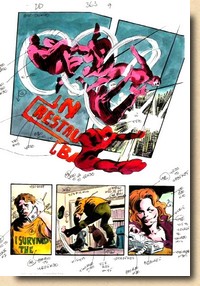
Daredevil
#363
(April 1997)
colour guide by Christie Scheele on a
production stat of Gene Colan's artwork
|
|
"[Film]
was really a black and white medium
when I grew up. Most of the
films that were in the theatres were
all black and white, we didn’t
have very many Technicolor films then
so I was brought up in a world of
black and white. Aside from
that, that’s how I saw
everything anyway. I wasn’t into
color it never occurred to me to have
anything colored, so I drew it in
black and white and if they wanted to
add color to it then go ahead, but
that’s just how I saw
things. Most of the inspiration
came from films and to me the movie
screen was just one gigantic comic
book panel." (Best,
2003)
"[It
was] at the age of 5 when I was
exposed to my first horror film. It
was Frankenstein. My father wanted to
see it and he took me along. Boy, did
that traumatize me! That was in 1931.
From then on, I was intrigued with
horror. I didn’t realize it in
those years, but it kind of crept up
on me. I sort of took what I loved
from the screen and put it on paper
(...) Whatever scary movie was out,
I'd see it, and a combination of
things, but I always had an affinity
for that stuff (...) I just love
the atmosphere - you know, old
castles, cemeteries, fog - all that
stuff. I've always been interested in
that." (Siuntres, 2005)
"[Stan
Lee] would just give me - and any of
the other artists that could do it -
a brief thumbnail idea of what the
plot was - this is the beginning,
this is the middle, and that's the
end - and I wouldn't come into the
city with that, I would tape record
him telling me the story over the
phone. That way I could follow the
message that he left for me, on the
recorder, and space it out the way he
tells it. And I would say 'well this
will take just so many pages and this
should take so many' and I would
equal it out until I felt that it
would - in my mind, I didn't make
notes or anything - that it should
eat up about 18 pages, and tell the
story. And sometimes I would run into
trouble and other times I would be
right on the nailhead. I just
couldn't stand doing thumbnail
sketches of these things, I just
wanted to get right to it - and I
would start with panel one." (Siuntres,
2005)
"You
know comic book artists never sit
down at a convention table to discuss
how they're gonna do this and how
they're gonna do that - it was always
over the phone, very quickly, or in
passing each other you'd spend a few
minutes talking about it, maybe
fifteen or so, and that would be it.
It's all that was required." (Siuntres,
2005)
"An
artist, as a rule, is not aware of a
style; he just does it. You
know when you write your name you
don’t think about how
you’re writing it but yet it can
be spotted by everyone and
they’ll know that that’s
you. When you’ve written
your name out it has a style to it,
it’s very hard to copy and
artwork is the same thing – it
has a style to it and you just don't
sit down and try to develop a style
it just happens. An unconscious
experience." (Best,
2003)
"There
are no two artists that look at
things the same way. Everybody has
their method of creating a
mood. I have mine, they have
theirs. Every time I did a job
I was basically entertaining myself,
having a good time with it, and I
enjoyed that. And even though I
would put lines down that I knew the
inker wouldn’t even begin to
bother with, I’d put them in
anyway, because it made the final
picture I’d be doing
finished. I gave it all I
could. Whether they inked it or
not, that was something else
again. Once it left my hands I
didn’t even care who inked
it. There was no point in
arguing with trying to get a specific
inker to work on your stuff because
they didn’t listen to you.
If they needed to a particular job
done in a hurry and all the best
inkers were working on other things
they would give it to somebody
else."
(Best, 2003)
"I
worked real hard on my art, why
should somebody come over and wreck
it up? So, I never really had a good
inker, not until Tom [Palmer] came
along. (...) I liked Tom's work very
much. It was weighty, and he put in
all the stuff that I liked - kind of
like a Caniff. My work is not easy to
follow, and he must've had a helluva
time with it. Tom is an illustrator
himself; he's done a lot of
advertising art. So, he was very
well-suited to it." (Field, 2001)
"Fortunately
for me the last ten years or so
I’ve had a lot of my work
printed only in pencil." (Best,
2003)
"The
only strip I really begged for was
Dracula. [Stan Lee] promised it to
me, but then he changed his mind, he
was going to give it to Bill Everett
(...) But I didn't take that for an
answer. I worked up a page of
Dracula, long before Bill did
anything (...) and I sent it in. I
got an immediate call back. Stan
said, "The strip is
yours"." (Thomas, 2000)
"I
don’t remember when it started
but I guess it started in the
‘60’s when they began to
give back to the artists, after the
stories were printed, the original
artwork. But if an artist, if a
penciler had to share the story with
an inker then the inker would get a
small percentage of it and the
penciler got most of it. Out of
an 18-page story an inker might get
five or six pages and then the
penciler would get all the
rest. So unless I inked it
myself I never got the full amount of
pages back at anytime, I would get
most of them back, but not all of
them." (Best,
2003)
"I think
comic books have gotten out of hand
these days because they show
everything that films portray and
they don’t spare anything.
They don’t leave anything to the
imagination of the reader."
(Best, 2003)
"I never
thought my career would take on the
proportions that it has (...) I was
just proud of the fact that I could
actually draw something and do a
story. (...) So it took off and the
proportion that it reached just
boggles the mind. I'm very fortunate
in that respect." (Best,
2010)
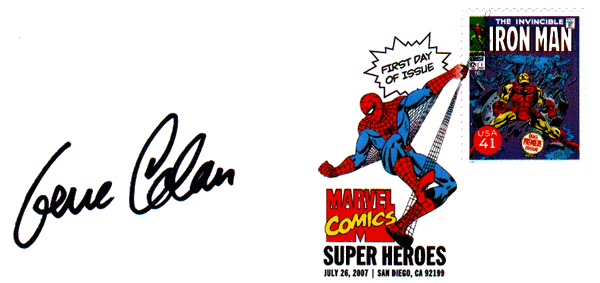
|
|
|
| |
|
| |
| BIBLOGRAPHY BEST
Daniel (2003) "Gene Colan Interview", www.adelaidecomicsandbooks.com
BEST
Daniel (2010) "Gene Colan Interview", www.ohdannyboy.blogspot.com
BOYLE
Christina (2011) "Gene Colan, comic book legend and
Bronx-born artist, dies at at 84", in New York
Daily News, 24 June 2011
DAUDT
Ron E. (N.A.) "Gerry Conway
Interview", www.wtv-zone.com
FIELD
Tom (2001) "The Colan Mystique, in Comic Book
Artist #13
IRVING
Christopher (2010) "Gene Colan: On
Vampires, Shadows, and the Industry", www.nycgraphicnovelists.com
KLAEHN
Jefferey (2010) "Gene Colan Interview", jefferyklaehn.blogspot.com
MATA
Shiai (2007) "Gene Colan
Interview", www.slayerlit.us
MOORE
Matt & Ula Ilnytzky (2011) "Gene Colan:
artist gave life to comic characters", in Boston
Globe, 25 June 2011
SIUNTRES
John (2005) Gene Colan Interview,
transcribed from the podcast Word Balloon: The Comic
Creator's Interview Show , available online at www.wordballoon.libsyn.com
SIUNTRES
John (2006) Marv Wolfman by Night,
transcribed from the podcast Word Balloon: The Comic
Creator's Interview Show , available online at www.wordballoon.libsyn.com
THOMAS
Michael David (2000) "Jim Shooter Interview", www.comicbookresources.com
THOMAS
Roy (2000) "So you want
a Job eh? The Gene Colan Interview", Alter
Ego (vol. 3 issue 6), www.twomorrows.com
|
| |
 |
     
|
| |
The
illustrations presented here are copyright
material. Their reproduction for the review
and research purposes of this website is
considered fair use as set out by the
Copyright Act of 1976, 17
U.S.C. par. 107.
BATMAN and all related elements are the
property of DC Comics, Inc. TM and © DC
Comics, Inc., a subsidiary of Time Warner
Inc.
Scans of original artwork and production art
are from my personal collection.
Text is (c)
2012-2016

The introductory
quote by Gene Colan is from Mata (2007)
page first
uploaded to the web 20 August 2016
|
|


